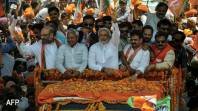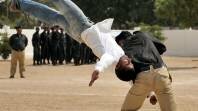On November 24, Pakistan Tehrik-e-Insaaf (PTI), determined to stop the drone program in Pakistan at any cost, staged a blockade in Peshawar along the route used by the NATO trucks that ferry supplies to and from Afghanistan. Fueled by a drone strike on November 21 that struck a seminary in the Hangu district of Khyber-Pakhtunkhwa (KPK), the PTI went about enforcing its directive to put an end to drone strikes. Truck drivers were harassed and pulled from vehicles, there were extrajudicial inspections of documentation of drivers, unidentified men fired shots into the air when police arrived, a scuffle broke out between drivers and PTI supporters, cases were registered against 40 PTI workers.
By day three, it was clear that this was a well-organized remonstration, prepared for the long-haul, with supporters working in rotating shifts to keep up the pressure and continue inspections unabated.
This was one aspect of a series of steps taken by the PTI and its allies. Protest rallies were organized in other parts of the country, including Karachi and Hyderabad. Jamaat-e-Islaami’s (JI) Siraj-ul-Haq delivered a letter of protest to the U.S. consulate in Peshawar, surrounded by anti-American and anti-drone sloganeering. Chief Minister KPK, Pervez Khattak wrote a letter to the Prime Minister Nawaz Sharif, urging that Pakistan take steps to put an end to drone strikes.
The government, on the other hand, accused Khan of trying to “ruin Pakistan’s international relations.” Imran Khan’s party raised the stakes on Nov. 27 by outing the name of the station chief of Central Intelligence Agency in Pakistan. Khan said he was not declaring a war against America but merely protesting against the U.S. policy of drone strikes.
Fahd Husain, Director News for a private television channel, feels that Imran Khan is treading on thin ice. “PTI has taken the law into its own hands completely violating the demarcation of powers between the federal and provincial governments. It’s a dangerous political game that Imran Khan is playing. Perhaps he is tempting fate deliberately.”
Beheading the hydra
The hellfire missile that broke the camel’s back was fired on November the first, mere days after Prime Minister Nawaz Sharif’s trip to the US concluded. The drone strike targeted and killed the leader of Tehrik-e-Taliban Pakistan (TTP), Hakeemullah Mehsud. The resulting racket drowned out the cries of the hundreds of civilian drone strike victims and plunged the country into a frenzied debate over the legality and effectiveness of drone strikes.Pakistani politicians, always eager to capitalize on the debate, jumped into the fray, oblivious to the repercussions of their statements.
Jamaat-e-Islami’s Khyber Pukhtunkhwa (KPK) head, Mohammad Ibrahim branded Mehsud a martyr, and party-head Munawar Hassan called the Pakistani soldiers who gave the ultimate sacrifice mere “dead bodies”. Fazl-ur-Rehman, the leader of Jamiat Ulema-e-Islam-F, claimed that even a dog killed by US forces should be called a martyr.
Interior Minister and senior leader for the Pakistan Muslim League - Nawaz (PML-N) Chaudhary Nisar claimed this latest strike was an “attack on peace”. Imran Khan vowed to protest drone strikes, and block NATO routes, a promise he has delivered on so far. His KPK head, Pervaiz Khattak alleged that the PML-N was indecisive and if PTI had been in power, it would shoot the drones down.
Mehsud is not the first Taliban leader to be killed in a drone strike in Pakistan. He certainly won’t be the last. According to the Long War Journal (LWJ), close to 96 Taliban and al Qaeda leaders have been killed in drone strikes, which accounts for less than 4% of the total deaths. Topping this list are leaders from the factions of The Haqqani Network, Abu Kasha al Iraqi, Mullah Nazir, Hakeemullah Mehsud, Hafiz Gul Bahadur, and Faqir Muhammad. LWJ claims that the number of civilians killed stands at 153, nearly 6% of the total deaths.
On October 30, 2013, another drone strike had killed between three to five low-ranking members of the Taliban, but the strike elicited no reaction from the government, political parties, or other stakeholders.
Yet, the Mehsud strike necessitated certain responses from the corridors of power to protect personal and party interests, and expand political clout and popularity.
“We don’t have a mature, democratic system,” says political analyst Haroon Rashid. “This phenomenon happens everywhere in the world, but stays within the ambit of constitutionality and public sentiment.”
“In Pakistan, the need to protect political interests and familial ties trumps the need for acting in the interests of the state,” Rashid said.
Broken strings
A few days prior to the first drone victim testimony in front of members of the Congress, a well-timed and scathing Amnesty International report alleged that 900 civilians had been killed since the start of the drone strikes in Pakistan. The confusion regarding the drone program in Pakistan can be assessed by the severe discrepancies in the data collected on the strikes. The Long War Journal, South Asian Terrorism Portal, Reprieve, Pakistan Body Count, Pitch Interactive, and dozens of other resources claim the number of drone strike to be somewhere between 350 and 370.
The number of civilians casualties range from as low as 67 since 2008 according to the Pakistani military, which constitutes as 3% of the total deaths resulting from drone strikes, centers around 300 since 2008 according to the Bureau of Investigative Journalism, and goes as high as the Amnesty International figure.
This is further complicated by the fact that since May 2008, the Pakistan Air Force has conducted over 5,500 strike sorties over the FATA region, a figure shared by Air Chief Marshall Rao Qamar Suleiman at the Air Chiefs Conference in Dubai. In said campaign, in excess of 10,600 bombs have been dropped, and 4,600 targets destroyed. The fact remains, there is a lot of misinformation regarding drone strikes in Pakistan, their efficacy and efficiency notwithstanding.
Pakistan’s official stance on drones is clear. Pakistan is against drone strikes, it violates the country’s sovereignty, serves as perhaps the biggest recruitment tool for the Taliban, and is counterproductive to the peace process in the long run. However, as is the case with every other aspect of this issue in Pakistan, this is challenged and confounded by a recent U.N. report which alleges that Pakistan was complicit in the drone program, and another report from The Washington Post that claims Pakistan gave permission for said strikes at least up to 2011.
Fahd Husain feels that political parties cannot come to consensus on how to stop the strikes. “There is widespread consensus among most political parties that these strikes are against the sovereignty of Pakistan. There has never been much dissent on that issue. However, there is a pronounced lack of consensus on how to go about stopping drone attacks.” Pakistan has almost always protested to the US delegation in Islamabad after every major drone strike, and universally condemned any drone attacks within its boundaries. “The lukewarm attitude come from the ambiguous realization that drones violate sovereignty but knock off the bad guys who remain out of our reach.”
In order to understand the stance of the various political parties, as well as their seemingly kneejerk reactions, two elements of this convoluted and controversial issue must be examined and understood. First, drones are here to stay for the foreseeable future. And second, the true debate is not the legality of the drone strikes, but what the Pakistani state is legally and constitutionally allowed to do (and perhaps supposed to do) on behalf of its citizens.
Deconstructing drones
Drones are here to stay. Since 2004, despite disparity between various think tanks and data crunchers, at least 350 drone strikes have been conducted in Pakistan. Pakistan, given its official anti-drone stance, has lodged protests with the Americans, most recently by summoning the US Ambassador to the foreign office over the November drone strike that killed Mehsud. “We know Obama will never compromise on drone attacks,” maintains a military official in Rawalpindi, on condition of anonymity. He says the high command closely follows internal US debates on Afghanistan and understands that drones have been the most potent weapons that Obama has at his disposal. For them, drones have delivered results, he says, even though for us they have severely undercut our position. “Drones we will have to live with,” the military official concludes.
His analysis is further reinforced by Obama’s speech in May, confirming the use of drones to target and incapacitate targets in the tribal regions of Pakistan, a vow to continue the strikes, and a framework under which the US felt it was fully justified in its use of drones to destroy and disrupt Taliban efforts. The primary justification is the Authorization for Use of Military Force (AUMF), an act passed by Congress in the days following the 9/11 attacks, giving the president authority to take “all necessary and appropriate force” against enemies of the state and their allies. This feeds into the Disposition Matrix, a system for tracking targets and ascertaining when and where they can be captured, or failing that, killed. The Disposition Matrix then helps to determine whether a personality strike (against an identified leader), a signature strike (against a suspected target, based on a “pattern of life” analysis), or a Terror Attack Disruption Strike (TADS - against targets where the identity is not known) is needed.
The justification is simple: the US is at war with al Qaeda and the Taliban, and individuals who aid and abet said enemies are to be treated as enemies themselves, and that the US will protect itself against potential threats and armed attacks. The legitimacy of this argument notwithstanding, unlike Pakistan, it does showcase a solemn and sincere effort to codify the framework for the sake of transparency and accountability. Ben Emerson, UN human rights special rapporteur, has already hailed this as a historic speech, because it “sets out more clearly and more authoritatively than ever before the administration’s legal justifications for targeted killing, and the constraints that it operates under.” The bottomline is, the US has invested too much into the drone program, financially, logistically, legislatively, and otherwise to back off now.
Droning on and on
Additionally, firing missiles is just one of the many uses of the drone program. They are used to assist in the overall Command, Control, Communications, Computers, Intelligence, Surveillance and Reconnaissance (C4ISR) logistics of ground forces. They are also used to check for roadside bombs or explosive devices near landing sites, listening to phone conversations, observing locals on a daily basis to see what constitutes as normal behavior, thus establishing what parameters to consider when conducting a signature strike.
Drones are cheap. The US has around 8,000, which accounts for one-third of all military aircraft. Yet 90% of Pentagon’s spending on air power is spent on manned aircraft. The most powerful drone in the US arsenal, the M-9 Reaper, costs nearly $12 million per unit. Whereas the corresponding manned aircraft, Lockheed Martin’s F-22, costs $377 million per unit on average. The per hour flight cost of a drone is also, on average, about 10 times less than that of a manned aircraft.
The cost of the equipment aside, a pair of boots on the ground costs the American taxpayers a whopping $1.3 million, according to a report by Center for Strategic and Budgetary Assessments (CSBA). With nearly 2,200 fatalities in Afghanistan, and thousands more injured, ground operations are becoming increasingly unpopular, especially when a drone can take out the target without putting a single American life at risk. Thus, an unmanned aerial drone, controlled by an unnamed soldier at Creech Air Base in the Nevada desert, presents a highly cost-effective, efficient solution which is, as of a Wall Street Journal poll in summer 2013, opposed by only 16% of Americans.
Most recently, in the Prime Minister Nawaz Sharif led delegation to the US, experts hypothesized that Pakistan’s stance on drones would be a major topic of discussion, one that Obama will need to tactfully address. Yet, on October 23, 2013, in a nearly 2,500 word joint statement by President Barack Obama and Prime Minister Nawaz Sharif, not a single word centered around drones. A week after the end of the tour, a drone strike took out three to five suspected militants, further cementing the fact that the drone strikes are here to stay.
Extrajudicially killing them softly
While the state’s stance on drones is quite unambiguous, what lacks is a unified strategy on what to do about it. The drama of political parties adopting the largely national disposition as their own unique perspective, and further applying self-serving political spins to it only results in creating unnecessary confusion. Politicians only seem interested in the pursuit of a few much-coveted brownie points with a highly aggravated public. In March of this year, Nawaz Sharif, while presenting his party’s election manifesto said, “Drone attacks are against the national sovereignty and a challenge for the country’s autonomy and independence. Therefore, we won’t tolerate these attacks in our territorial jurisdictions.” Shortly before taking his oath as the Prime Minister of Pakistan, on June 5, 2013, he declared in his first speech from the floor of the National Assembly that “the daily business of drones must come to an end.” Since then, nine drone strikes have been conducted in FATA.
Bilawal Bhutto Zardari, chairman of Pakistan People’s Party said in an interview to MSNBC, “The continuous carpet bombing of Pakistan by drones is not only counterproductive on the war on terror, it’s also an egregious violation of our sovereignty and must end.” Once again, it reiterates the stance of two successive governments, but outlines no execution strategy if the drone strikes are not stopped. Imran Khan, leader of Pakistan Tehrik-e-Insaaf (PTI) has repeatedly insisted on stopping drone attacks in the country, urging the Prime Minister-elect in May to treat the issues of stopping drones as his first and foremost agenda item. In August, Senator Shahi Syed of the Awami National Party (ANP) urged PTI to describe its policy against drones attacks in the KPK province.
Feisal H. Naqvi, a senior lawyer, recently appointed as an amicus by the Lahore High Court in a petition against drone strikes, has an altogether different view point. He believes that Pakistan simply does not have the right, constitutionally speaking, to allow drones attacks in their current form. “Article 10-A of the constitution clearly says that all persons within the country are allowed due process. The definition of due process is debatable, but it certainly does not cover extrajudicial killings”, he says. “It is the job of the executive branch, the federal government, to determine what to do in a situation where it feels the sovereignty is being violated, in accordance with the constitution. If there is any ambiguity, or if clarification is needed, the matter can be taken to the Supreme Court for interpretation.”
Pakistan has many options when it comes to dealing with drone strikes in the country. Pakistan can approach the UN, and challenge the legal framework under which the US conducts drone strikes, arguing that it does not fall under the ambit of the three exceptions under which one sovereign state can conduct military operations on another nation’s soil. Pakistan can approach the International Court of Justice for an advisory take on the matter. In an extreme example, the unmanned aerial vehicles can even be shot down by the PAF. On the flip side, if Pakistan wants drone strikes, it must approach them legally, by declaring an emergency under Article 232 of the constitution, suspending fundamental rights in target areas, and sharing an accountability framework. As it stands, lack of a political will from any party has squarely placed Pakistan in that tenuous, murky region between vehement verbal opposition and political lip service, and a distinct lack of tangible action.
Haroon Rashid also believes that the origin of the problem lies within the state. “By all accounts, this is a massive failure of the state to establish its writ on its own soil. One way to mitigate the need for drone strikes is to rapidly increase ground intelligence, or to decide as a state that extremist elements must be routed via a comprehensive military operation. All this criticism of one another, this endless barrage of accusing political rivals of not doing enough is a facade, because when given the same power, it has resulted in zero change in the status quo.”
“What you have here is a failure to take responsibility by the Pakistani state,” says Naqvi. “There is a distinct lack of integrity. There seems to be a very strange disconnect between governance and the issue of drones. The elemental question is whether we want drone strikes or not. If the answer is no, the government must take action to put an end to them, or accept that drone strikes are happening because we want them to happen. The rest is just political rhetoric.”
The political rhetoric is also severely criticised by Rashid. “Since 1948, there has been no political personality, or party, that has operated in accordance with the national interest before personal or business gains.”
Rashid pointed out that the pattern of leveraging any situation to advance personal or party agendas is now so deeply embedded within the political discourse in Pakistan, national interests, or the needs of its citizens are secondary or tertiary concerns.
“Whether it is PMLN, or PTI, or the PPP, the issue of drones will always be secondary, because of primary concern is what they can gain from making a public statement,” Rashid said.
There is ample evidence to suggest that drones are here to stay. The indeterminate state of the state of Pakistan is largely self-imposed, resulting from a wide variety of factors, chief amongst them a lack of political will and a tacit acceptance of the state’s failure to establish its writ in the tribal belt.
Pakistan needs to decide a) whether it wants drone strikes or not, and b) based on the former, either develop the legal, transparent framework to allow them, or take decisive action to stop them. Only politicians and bureaucrats stand to benefit from shallow political statements and hollow promises, suspending the country in a nebulous state of drone-struck limbo.
The author is a journalist and a development professional, and holds a Master’s degree in strategic communications from Ithaca College, New York. He tweets@zeesalahuddin























